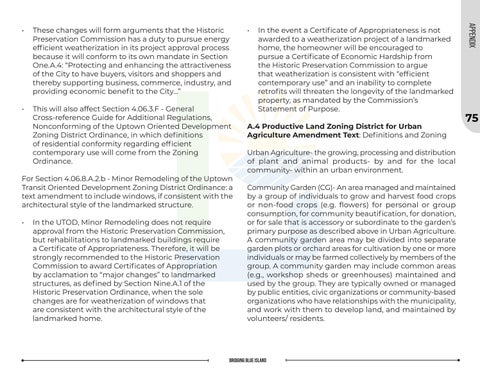These changes will form arguments that the Historic Preservation Commission has a duty to pursue energy efficient weatherization in its project approval process because it will conform to its own mandate in Section One.A.4: “Protecting and enhancing the attractiveness of the City to have buyers, visitors and shoppers and thereby supporting business, commerce, industry, and providing economic benefit to the City...”
•
This will also affect Section 4.06.3.F - General Cross-reference Guide for Additional Regulations, Nonconforming of the Uptown Oriented Development Zoning District Ordinance, in which definitions of residential conformity regarding efficient contemporary use will come from the Zoning Ordinance.
For Section 4.06.8.A.2.b - Minor Remodeling of the Uptown Transit Oriented Development Zoning District Ordinance: a text amendment to include windows, if consistent with the architectural style of the landmarked structure. •
In the UTOD, Minor Remodeling does not require approval from the Historic Preservation Commission, but rehabilitations to landmarked buildings require a Certificate of Appropriateness. Therefore, it will be strongly recommended to the Historic Preservation Commission to award Certificates of Appropriation by acclamation to “major changes” to landmarked structures, as defined by Section Nine.A.1 of the Historic Preservation Ordinance, when the sole changes are for weatherization of windows that are consistent with the architectural style of the landmarked home.
•
In the event a Certificate of Appropriateness is not awarded to a weatherization project of a landmarked home, the homeowner will be encouraged to pursue a Certificate of Economic Hardship from the Historic Preservation Commission to argue that weatherization is consistent with “efficient contemporary use” and an inability to complete retrofits will threaten the longevity of the landmarked property, as mandated by the Commission’s Statement of Purpose.
A.4 Productive Land Zoning District for Urban Agriculture Amendment Text: Definitions and Zoning Urban Agriculture- the growing, processing and distribution of plant and animal products- by and for the local community- within an urban environment. Community Garden (CG)- An area managed and maintained by a group of individuals to grow and harvest food crops or non-food crops (e.g. flowers) for personal or group consumption, for community beautification, for donation, or for sale that is accessory or subordinate to the garden’s primary purpose as described above in Urban Agriculture. A community garden area may be divided into separate garden plots or orchard areas for cultivation by one or more individuals or may be farmed collectively by members of the group. A community garden may include common areas (e.g., workshop sheds or greenhouses) maintained and used by the group. They are typically owned or managed by public entities, civic organizations or community-based organizations who have relationships with the municipality, and work with them to develop land, and maintained by volunteers/ residents.
bridging blue island
APPENDIX
•
75


























